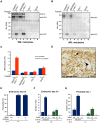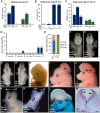Reduced prostasin (CAP1/PRSS8) activity eliminates HAI-1 and HAI-2 deficiency-associated developmental defects by preventing matriptase activation
- PMID: 22952456
- PMCID: PMC3431340
- DOI: 10.1371/journal.pgen.1002937
Reduced prostasin (CAP1/PRSS8) activity eliminates HAI-1 and HAI-2 deficiency-associated developmental defects by preventing matriptase activation
Abstract
Loss of either hepatocyte growth factor activator inhibitor (HAI)-1 or -2 is associated with embryonic lethality in mice, which can be rescued by the simultaneous inactivation of the membrane-anchored serine protease, matriptase, thereby demonstrating that a matriptase-dependent proteolytic pathway is a critical developmental target for both protease inhibitors. Here, we performed a genetic epistasis analysis to identify additional components of this pathway by generating mice with combined deficiency in either HAI-1 or HAI-2, along with genes encoding developmentally co-expressed candidate matriptase targets, and screening for the rescue of embryonic development. Hypomorphic mutations in Prss8, encoding the GPI-anchored serine protease, prostasin (CAP1, PRSS8), restored placentation and normal development of HAI-1-deficient embryos and prevented early embryonic lethality, mid-gestation lethality due to placental labyrinth failure, and neural tube defects in HAI-2-deficient embryos. Inactivation of genes encoding c-Met, protease-activated receptor-2 (PAR-2), or the epithelial sodium channel (ENaC) alpha subunit all failed to rescue embryonic lethality, suggesting that deregulated matriptase-prostasin activity causes developmental failure independent of aberrant c-Met and PAR-2 signaling or impaired epithelial sodium transport. Furthermore, phenotypic analysis of PAR-1 and matriptase double-deficient embryos suggests that the protease may not be critical for focal proteolytic activation of PAR-2 during neural tube closure. Paradoxically, although matriptase auto-activates and is a well-established upstream epidermal activator of prostasin, biochemical analysis of matriptase- and prostasin-deficient placental tissues revealed a requirement of prostasin for conversion of the matriptase zymogen to active matriptase, whereas prostasin zymogen activation was matriptase-independent.
Conflict of interest statement
The authors have declared that no competing interests exist.
Figures







References
-
- Scott HS, Kudoh J, Wattenhofer M, Shibuya K, Berry A, et al. (2001) Insertion of beta-satellite repeats identifies a transmembrane protease causing both congenital and childhood onset autosomal recessive deafness. Nat Genet 27: 59–63. - PubMed
Publication types
MeSH terms
Substances
Grants and funding
LinkOut - more resources
Full Text Sources
Molecular Biology Databases
Research Materials
Miscellaneous

